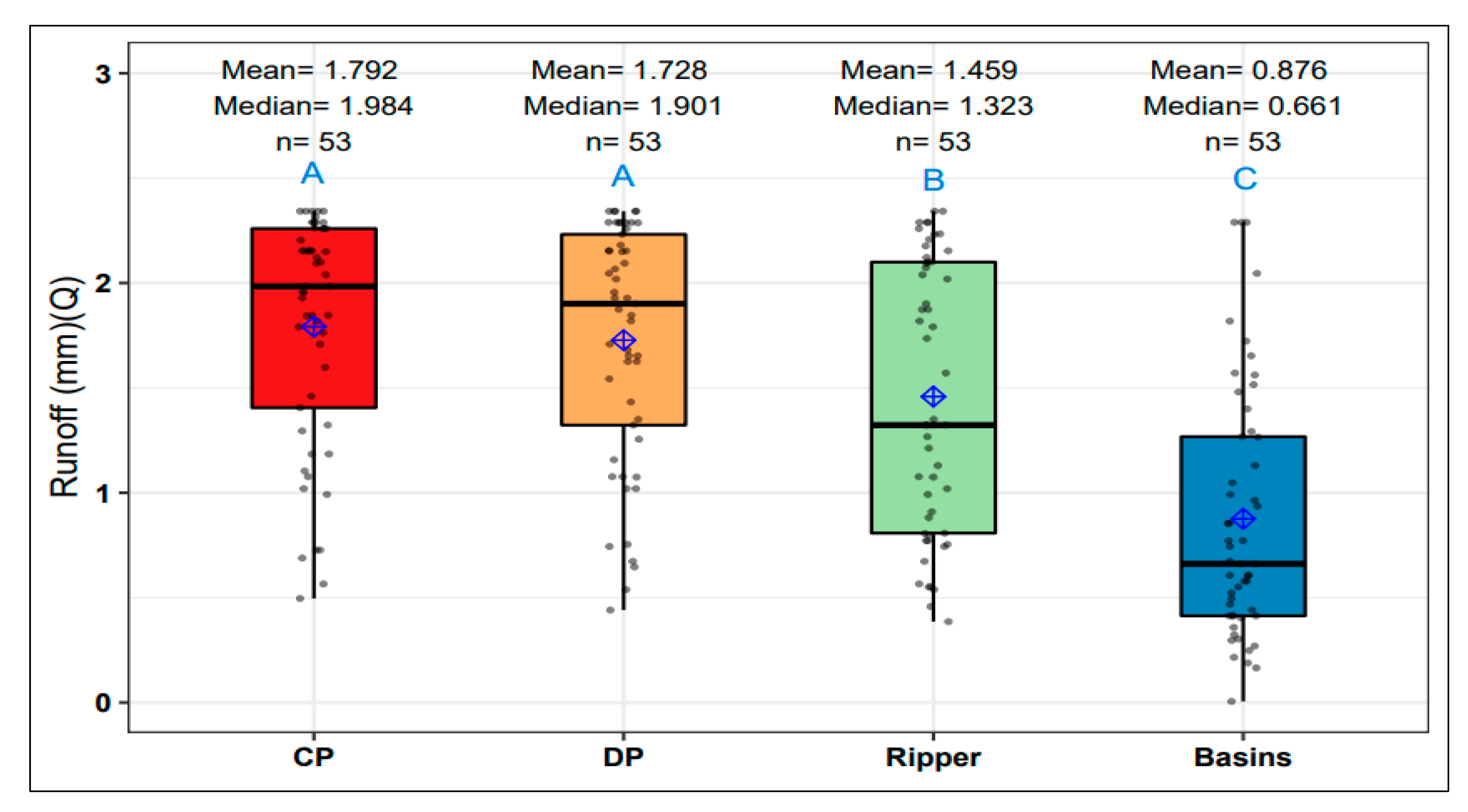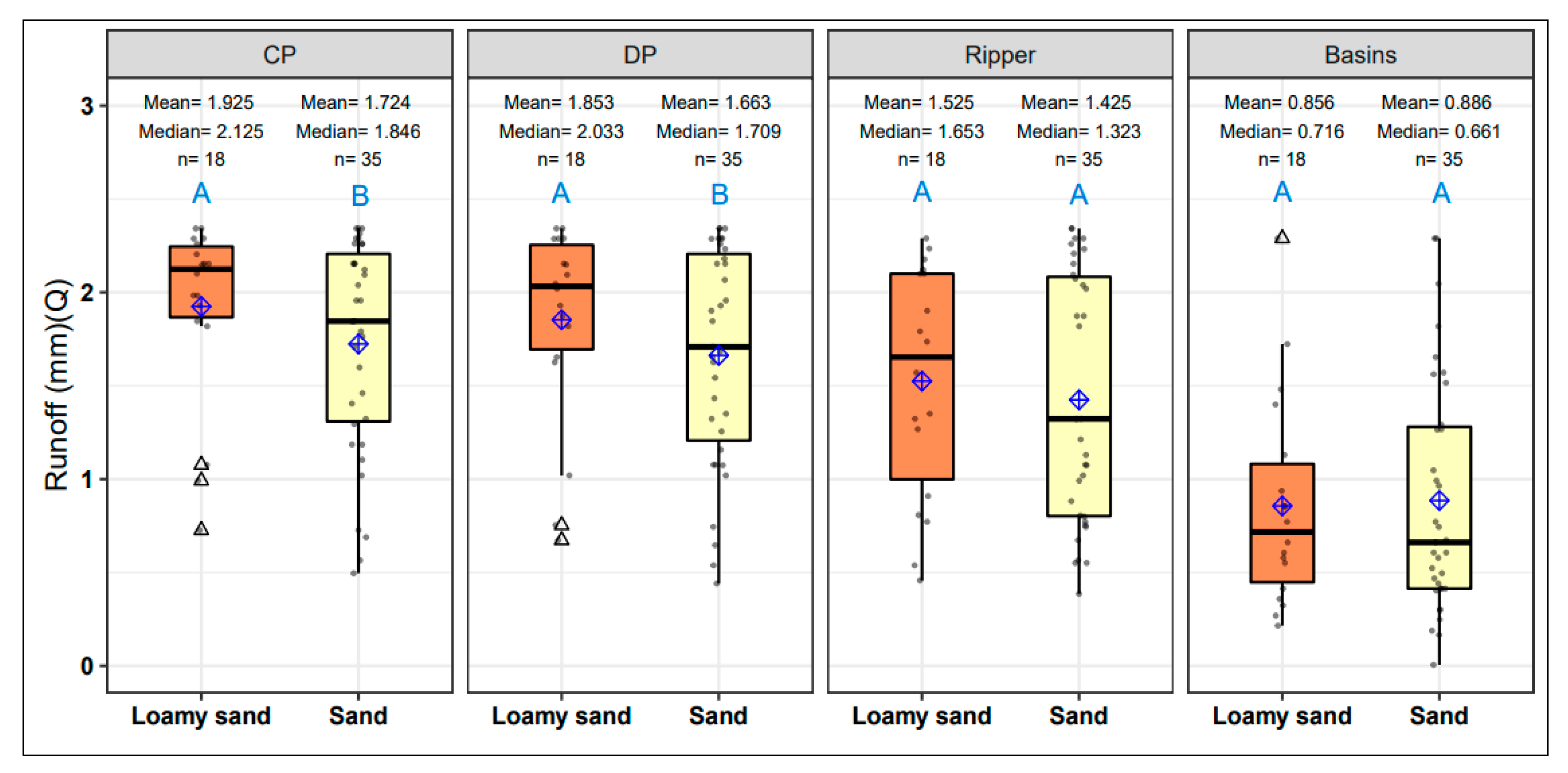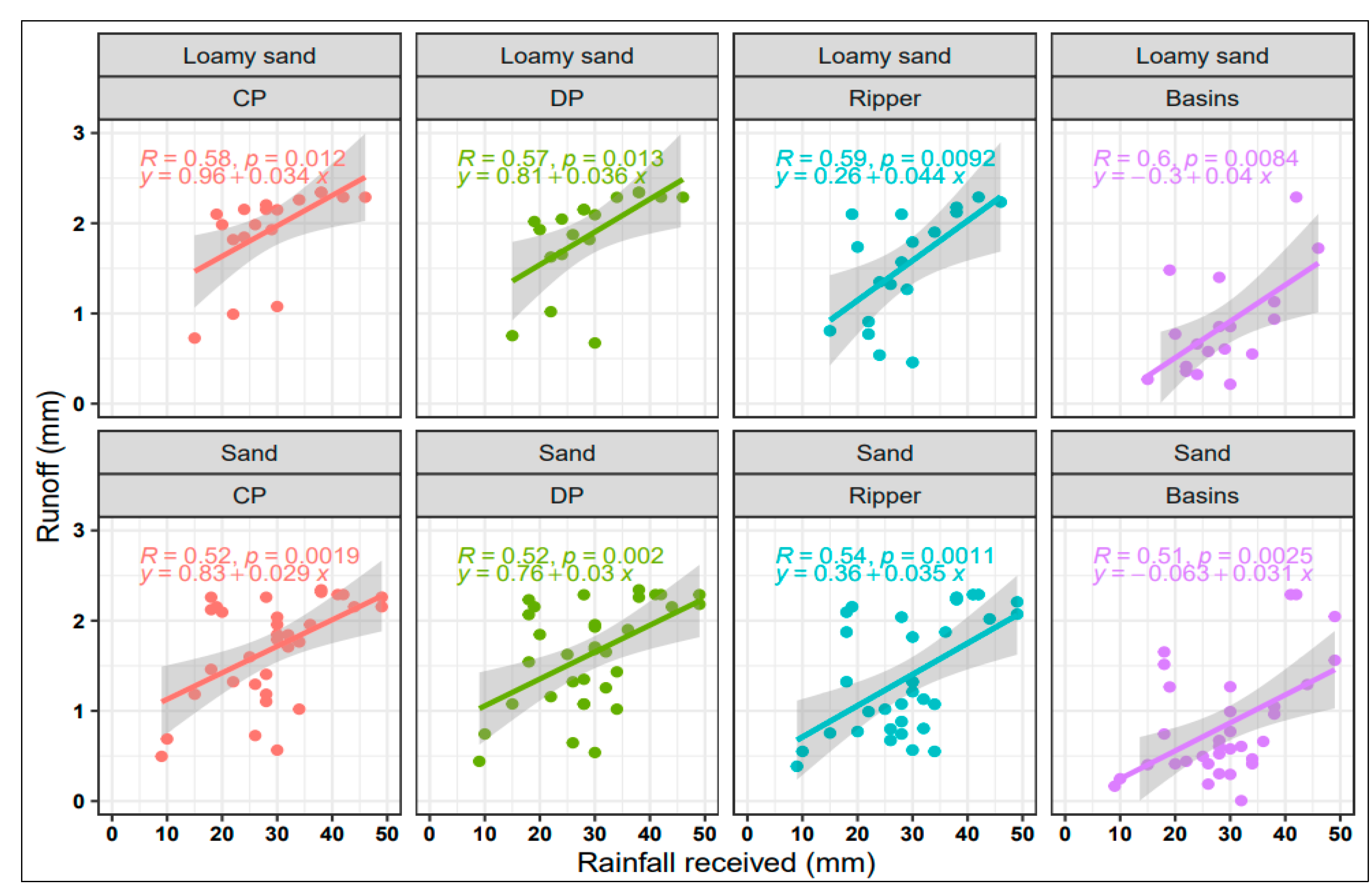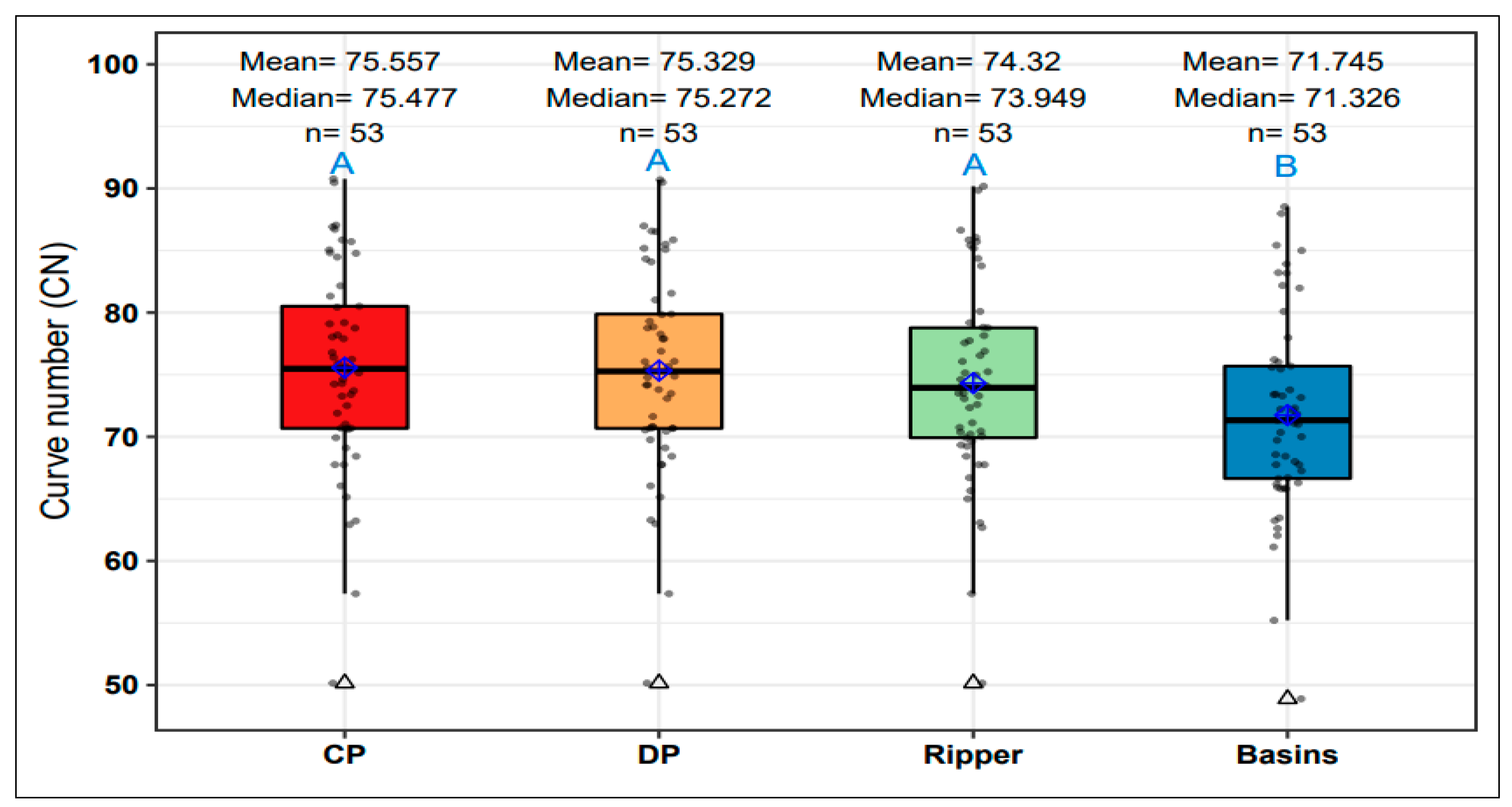Deriving Surface Water Storage and Curve Numbers from Rainfall–Runoff Relationships in Conventional and Minimum Tillage Systems in Gwanda, Zimbabwe
Abstract
1. Introduction
2. Materials and Methods
2.1. Description of Experimental Sites
2.2. Experimental Set-Up
2.3. Data Collection and Calculation of Surface Water Retention and Curve Numbers
2.3.1. Daily Rainfall Measurements
2.3.2. Runoff Generated from tillage Treatments
2.3.3. Calculation of Surface Retention and Curve Numbers
2.4. Statistical Analyses
- is the intercept;
- is the dependent variable, and surface water retention, runoff, and CNs;
- are the weights of the independent variables tillage method and soil type, respectively, represents the tillage method levels (CP, DP, Ripper, and Basins), whilst represents soil type levels (loamy sand and sand);
- is the combined (interaction) weight contribution of the jth level of tillage method and the kth level of soil type;
- are the independent variables tillage method and soil type, respectively at different levels as specified above;
- is the regression error term.
3. Results and Discussion
3.1. Runoff Generating Rainfall Recorded at Experimental Sites
3.2. Runoff Generated in the Four Tillage Treatments
3.3. Soil Texture Effect on Runoff Generation
3.4. Surface Water Retention and CN in Tillage Treatments
4. Conclusions
Supplementary Materials
Author Contributions
Funding
Institutional Review Board Statement
Informed Consent Statement
Data Availability Statement
Acknowledgments
Conflicts of Interest
References
- Rockström, J.; Barron, J.; Fox, P. Rainwater management for increased productivity among small-holder farmers in drought prone environments. Phys. Chem. Earth Parts A/B/C 2002, 27, 949–959. [Google Scholar] [CrossRef]
- Biazin, B.; Sterk, G.; Temesgen, M.; Abdulkedir, A.; Stroosnijder, L. Rainwater harvesting and management in rainfed agricultural systems in sub-Saharan Africa—A review. Phys. Chem. Earth Parts A/B/C 2012, 47, 139–151. [Google Scholar] [CrossRef]
- Rosegrant, M.W.; Cai, X.; Cline, S.A. World Water and Food to 2025: Dealing with Scarcity; IFPRI-2020 Vision/International Water Management Institute Book; International Food Policy Research Institute: Washington, DC, USA, 2002. [Google Scholar]
- Nyamudeza, P. The effects of growing sorghum (Sorghum bicolor L.) in furrows and on the flat at three populations and three row widths in a semi-arid region of Zimbabwe. 1. Grain yield and yield components. Zimb. J. Agric. Res. 1993, 31, 1–10. [Google Scholar]
- Motsi, K.E.; Chuma, E.; Mukamuri, B.B. Rainwater harvesting for sustainable agriculture in communal lands of Zimbabwe. Phys. Chem. Earth Parts A/B/C 2004, 29, 1069–1073. [Google Scholar] [CrossRef]
- Mupangwa, W.; Love, D.; Twomlow, S. Soil–water conservation and rainwater harvesting strategies in the semi-arid Mzingwane Catchment, Limpopo Basin, Zimbabwe. Phys. Chem. Earth Parts A/B/C 2006, 31, 893–900. [Google Scholar] [CrossRef]
- Vogel, H. Tillage effects on maize yield, rooting depth and soil water content on sandy soils in Zimbabwe. Field Crops Res. 1992, 33, 376–384. [Google Scholar] [CrossRef]
- Nyagumbo, I. Conservation tillage for sustainable crop production systems: Experiences from on-station and on-farm research in Zimbabwe. In Conservation Tillage with Animal Traction. A Resource Book of the Animal Traction Network for Eastern and Southern Africa (ATNESA); Kambutho, P.G., Simalenga, T.E., Eds.; Animal Traction Network of Eastern and Southern Africa: Harare, Zimbabwe, 1999; pp. 108–115. Available online: http://www.atnesa.org (accessed on 22 August 2023).
- Thierfelder, C.; Wall, P.C. Effects of conservation agriculture techniques on infiltration and soil water content in Zambia and Zimbabwe. Soil Tillage Res. 2009, 105, 217–227. [Google Scholar] [CrossRef]
- Kassam, A.; Derpsch, R.; Friedrich, T. Global achievements in soil and water conservation: The case of Conservation Agriculture. Int. Soil Water Conserv. Res. 2014, 2, 5–13. [Google Scholar] [CrossRef]
- Mupangwa, W.; Chipindu, L.; Ncube, B.; Mkuhlani, S.; Nhantumbo, N.; Masvaya, E.; Ngwira, A.; Moeletsi, M.; Nyagumbo, I.; Liben, F. Temporal Changes in Minimum and Maximum Temperatures at Selected Locations of Southern Africa. Climate 2023, 11, 84. [Google Scholar] [CrossRef]
- Mupangwa, W.; Twomlow, S.; Walker, S. The influence of conservation tillage methods on soil water regimes in semi-arid southern Zimbabwe. Phys. Chem. Earth Parts A/B/C 2008, 33, 762–767. [Google Scholar] [CrossRef]
- Degefa, A.; Quraishi, S.; Abegaz, F. Effects of different soil management practices under maize-legume production system on rainfall-runoff and soil loss relationships in Bako, West Oromia, Ethiopia. J. Resour. Dev. Manag. 2016, 26, 27–34. [Google Scholar]
- Vigiak, O.; Ribolzi, O.; Pierret, A.; Sengtaheuanghoung, O.; Chaplot, V.; Valentin, C. Estimation of runoff curve number (CN) of some Laotian land use types. Lao J. Agric. For. 2008, 16, 49–60. Available online: https://hdl.handle.net/10568/40801 (accessed on 23 May 2023).
- Jung, J.W.; Yoon, K.S.; Choi, D.H.; Lim, S.S.; Choi, W.J.; Choi, S.M.; Lim, B.J. Water management practices and SCS curve numbers of paddy fields equipped with surface drainage pipes. Agric. Water Manag. 2012, 110, 78–83. [Google Scholar] [CrossRef]
- Benimana, J.C.; Wali, U.G.; Nhapi, I.; Anyemedu, F.O.K.; Gumindoga, W. Rainwater harvesting potential for crop production in the Bugesera district of Rwanda. Afr. J. Agric. Res. 2015, 10, 2020–2031. [Google Scholar] [CrossRef]
- Soil Conservation Service. Hydrology. In National Engineering Handbook; Department of Agriculture: Washington, DC, USA, 1972; Section 4, Chapter 21; 762p. Available online: https://directives.sc.egov.usda.gov (accessed on 14 June 2023).
- González-Álvarez, Á.; Temimi, M.; Khanbilvardi, R. Adjustment to the curve number (NRCS-CN) to account for the vegetation effect on hydrological processes. Hydrol. Sci. J. 2015, 60, 591–605. [Google Scholar] [CrossRef]
- Caletka, M.; Michalková, M.; Karásek, P.; Fučík, P. Improvement of SCS-CN Initial Abstraction Coefficient in the Czech Republic: A Study of Five Catchments. Water 2020, 12, 1964. [Google Scholar] [CrossRef]
- Schmidt, E.J.; Schulze, R.E.; Dent, M.C. Flood Volume and Peak Discharge from Small Catchments in Southern Africa, Based on the SCS Technique: Agricultural Catchments Research Unit Report No. 24. Water Research Commission Project No. 155. South Africa. 1987. Available online: https://www.wrc.org.za/wp-content/uploads/mdocs/TT-31-87.pdf (accessed on 14 June 2023).
- Govers, G.; Takken, I.; Helming, K. Soil roughness and overland flow. Agron. 2000, 20, 131–146. [Google Scholar] [CrossRef]
- Dimes, J.; Malherbe, J. Climate variability and simulation modeling―Challenges and opportunities. In Livelihoods in the Limpopo: CGIAR Challenge Program on Water and Food Project No. 1, Increased Food Security and Income in the Limpopo Basin through Integrated Crops, Soil Fertility and Water Management Options and Links to Markets, Proceedings of the CPWFPN 1 Inception Workshop, Polokwane, South Africa, 25–27 January 2005; Mgonja, M.A., Waddington, S., Rollin, D., Masenya, M., Eds.; Scientific Research Publishing: Wuhan, China, 2006. [Google Scholar]
- Chaki, A.K.; Gaydon, D.S.; Dalal, R.C.; Bellotti, W.D.; Gathala, M.K.; Hossain, A.; Menzies, N.W. How we used APSIM to simulate conservation agriculture practices in the rice-wheat system of the Eastern Gangetic Plains. Field Crops Res. 2022, 275, 108344. [Google Scholar] [CrossRef]
- Natural Resources Conservation Service (NRCS). Urban Hydrology for Small Watersheds; Technical Release 55, June 1986; United States Department of Agriculture: Washington, DC, USA, 1986.
- Shamudzarira, Z.; Robertson, M.J. Simulating Response of Maize to Nitrogen Fertilizer in Semi-Arid Zimbabwe. Exp. Agric. 2002, 38, 79–96. [Google Scholar] [CrossRef][Green Version]
- Ncube, B.; Dimes, J.P.; van Wijk, M.T.; Twomlow, S.J.; Giller, K.E. Productivity and residual benefits of grain legumes to sorghum under semi-arid conditions in south-western Zimbabwe: Unravelling the effects of water and nitrogen using a simulation model. Field Crops Res. 2009, 110, 173–184. [Google Scholar] [CrossRef]
- Chikowo, R.; Corbeels, M.; Mapfumo, P.; Tittonell, P.; Vanlauwe, B.; Giller, K.E. Nitrogen and phosphorus capture and recovery efficiencies, and crop responses to a range of soil fertility management strategies in sub-Saharan Africa. In Innovations as Key to the Green Revolution in Africa; Springer: Berlin/Heidelberg, Germany, 2011; pp. 571–589. [Google Scholar] [CrossRef]
- Mwansa, F.B.; Munyinda, K.; Mweetwa, A.; Mupangwa, W. Assessing the Potential of Conservation Agriculture to Off-set the Effects of Climate Change on Crop Productivity using Crop Simulations Model (APSIM). Int. J. Sci. Footpr. 2017, 5, 9–32. [Google Scholar]
- Nezomba, H.; Mtambanengwe, F.; Rurinda, J.; Mapfumo, P. Integrated soil fertility management sequences for reducing climate risk in smallholder crop production systems in southern Africa. Field Crops Res. 2018, 224, 102–114. [Google Scholar] [CrossRef]
- Singh, P.; Mishra, S.K. Determination of curve number and estimation of runoff using Indian experimental rainfall and runoff data. J. Spat. Hydrol. 2017, 13, 2. Available online: https://scholarsarchive.byu.edu/josh/vol13/iss1/2 (accessed on 20 April 2023).
- Mupangwa, W.; Dimes, J.; Walker, S.; Twomlow, S. Measuring and simulating maize (Zea mays L.) yield responses to reduced tillage and mulching under semi-arid conditions. Agric. Sci. 2011, 2, 167–174. [Google Scholar] [CrossRef]
- Mupangwa, W.; Jewitt, G. Simulating the impact of no-till systems on field water fluxes and maize productivity under semi-arid conditions. Phys. Chem. Earth Parts A/B/C 2011, 36, 1004–1011. [Google Scholar] [CrossRef]
- Food and Agriculture Organization (FAO). Fertilizer Use by Crop in Zimbabwe. Land and Plant Nutrition Services; Land and Water Development Division, Food and Agriculture Organisation of the United Nations: Rome, Italy, 2006. [Google Scholar]
- Anderson, I.P.; Brinn, P.J.; Moyo, M.; Nyamwanza, B. Physical Resource Inventory of the Communal Lands of Zimbabwe—An Overview (NRI Bulletin 60); Natural Resources Institute: Madison, WI, USA, 1993. [Google Scholar]
- Nyamapfene, K.W. The Soils of Zimbabwe; Nehanda Publishers: Harare, Zimbabwe, 1991; Volume 1, 179p. [Google Scholar]
- Love, D.; Uhlenbrook, S.; Corzo-Perez, G.; Twomlow, S.; van der Zaag, P. Rainfall–interception–evaporation–runoff relationships in a semi-arid catchment, northern Limpopo basin, Zimbabwe. Hydrol. Sci. J. 2010, 55, 687–703. [Google Scholar] [CrossRef][Green Version]
- Mhizha, A.; Ndiritu, J.G. Assessing crop yield benefits from in situ rainwater harvesting through contour ridges in semi-arid Zimbabwe. Phys. Chem. Earth Parts A/B/C 2013, 66, 123–130. [Google Scholar] [CrossRef]
- Twomlow, S.J.; Urolov, J.C.; Oldrieve, B.; Jenrich, M. Lessons from the field—Zimbabwe’s conservation agriculture taskforce. SAT Agric. Res. 2008, 6, 1–11. [Google Scholar]
- Hawkins, R.H. Improved Prediction of Storm Runoff in Mountain Watersheds. J. Irrig. Drain. Div. 1973, 99, 519–523. [Google Scholar] [CrossRef]
- Zhao, L.; Hou, R.; Wu, F.; Keesstra, S. Effect of soil surface roughness on infiltration water, ponding and runoff on tilled soils under rainfall simulation experiments. Soil Tillage Res. 2018, 179, 47–53. [Google Scholar] [CrossRef]
- Bruneau, P.; Twomlow, S. Hydrological and Physical Responses of a Semi-arid Sandy Soil to Tillage. J. Agric. Eng. Res. 1999, 72, 385–391. [Google Scholar] [CrossRef]
- van der Meer, F.B.W. Modelling Tropical Soil Water Regimes in Semi-Arid Environments. Ph.D. Dissertation, Loughborough University, Loughborough, UK, 2000. [Google Scholar]
- Haruna, S.I.; Anderson, S.H.; Nkongolo, N.V.; Zaibon, S. Soil Hydraulic Properties: Influence of Tillage and Cover Crops. Pedosphere 2018, 28, 430–442. [Google Scholar] [CrossRef]
- Shinde, S.S.; Magar, S.S.; Kale, S.P. Effect of soil physical conditions and initial soil moisture content on infiltration into black soil. J. Indian Soc. Soil Sci. 1982, 30, 441–446. [Google Scholar]
- Twomlow, S.J.; Steyn, J.T.; Du Preez, C.C.; Peterson, G.A.; Unger, P.W.; Payne, W.A. Dryland Farming in Southern Africa. Dryland Agric. 2006, 23, 769–836. [Google Scholar] [CrossRef]
- Wang, J.; Watts, D.B.; Meng, Q.; Zhang, Q.; Way, T.R. Influence of surface crusting on infiltration of a Loess Plateau soil. Soil Sci. Soc. Am. J. 2016, 80, 683–692. [Google Scholar] [CrossRef]
- Jones, O.R.; Eck, H.V.; Smith, S.J.; Coleman, G.A.; Hauser, V.L. Runoff, soil, and nutrient losses from rangeland and dry-farmed cropland in the southern High Plains. J. Soil Water Conserv. 1985, 40, 161–164. [Google Scholar]
- Baumhardt, R.L.; Marek, G.; Brauer, D. Trends in runoff from dryland, cropped fields on the texas high plains, and implications for their management. Front. Sustain. Food Syst. 2020, 4, 217. [Google Scholar] [CrossRef]
- Du Plessis, M.C.; Mostert, J.W.C. Runoff and soil losses at the Agricultural Research Centre. Glen. S. Afr. J. Agric. Sci. 1965, 8, 1051–1061. [Google Scholar]
- Hensley, M.; Botha, J.J.; Anderson, J.J.; Van Staden, P.P.; Du Toit, A. Optimizing Rainfall Use Efficiency for Developing Farmers with Limited Access to Irrigation Water (No. 878/1, p. 00); Water Research Commission: Pretoria, South Africa, 2000. [Google Scholar]
- Jourgholami, M.; Labelle, E.R. Effects of plot length and soil texture on runoff and sediment yield occurring on machine-trafficked soils in a mixed deciduous forest. Ann. For. Sci. 2020, 77, 1–11. [Google Scholar] [CrossRef]
- Ngwira, A.R.; Thierfelder, C.; Lambert, D.M. Conservation agriculture systems for Malawian smallholder farmers: Long-term effects on crop productivity, profitability and soil quality. Renew. Agric. Food Syst. 2013, 28, 350–363. [Google Scholar] [CrossRef]










| Experimental Site | pH (Water) | O.C. (mg kg−1) | Total N (mg kg−1) | Total P (mg kg−1) | Bulk Density (g cm−3) |
|---|---|---|---|---|---|
| Mguni | 6.0 | 5.6 | 0.5 | 0.20 | 1.50 |
| Moyo | 5.9 | 5.8 | 0.6 | 0.06 | 1.49 |
| Mpofu | 5.2 | 4.1 | 0.3 | 0.07 | 1.46 |
| Nkomo | 5.6 | 3.6 | 0.2 | 0.06 | 1.50 |
| Mlalazi | 5.5 | 3.6 | 0.2 | 0.09 | 1.52 |
| Ncube N | 6.5 | 3.4 | 0.2 | 0.02 | 1.52 |
| Nyathi | 6.3 | 2.9 | 0.3 | 0.08 | 1.51 |
| Ncube J | 5.3 | 3.3 | 0.3 | 0.09 | 1.49 |
| Sibanda | 5.6 | 4.6 | 0.3 | 0.21 | 1.51 |
| Siziba | 6.1 | 7.1 | 0.6 | 0.19 | 1.56 |
| Lsd0.05 | 0.53 | 1.8 | 0.33 | 0.07 | 0.020 |
| CV (%) | 7.3 | 29 | 40 | 43 | 1.1 |
| Tillage Pair-Wise Comparison | Estimate | S.E. | T-Value | p-Value |
|---|---|---|---|---|
| DP-CP | −0.06431 | 0.11470 | −0.561 | 0.9435 |
| Ripper-CP | −0.33331 | 0.11470 | −2.906 | 0.0209 * |
| Basins-CP | −0.91634 | 0.11470 | −7.989 | <0.001 *** |
| Ripper-DP | −0.26900 | 0.11470 | −2.345 | 0.0911 |
| Basins-DP | −0.85203 | 0.11470 | −7.428 | <0.001 *** |
| Basins-Ripper | −0.58303 | 0.11470 | −5.083 | <0.001 *** |
| Parameter | Treatment | DF | SS | MS | F-Value | p-Value |
|---|---|---|---|---|---|---|
| SWR | Tillage method | 3 | 11,023 | 3674 | 2.193 | 0.090 |
| Residuals | 208 | 348,523 | 1676 | |||
| Curve number | Tillage method | 3 | 485 | 161.7 | 2.488 | 0.0615 |
| Residuals | 208 | 13,520 | 65.0 |
Disclaimer/Publisher’s Note: The statements, opinions and data contained in all publications are solely those of the individual author(s) and contributor(s) and not of MDPI and/or the editor(s). MDPI and/or the editor(s) disclaim responsibility for any injury to people or property resulting from any ideas, methods, instructions or products referred to in the content. |
© 2023 by the authors. Licensee MDPI, Basel, Switzerland. This article is an open access article distributed under the terms and conditions of the Creative Commons Attribution (CC BY) license (https://creativecommons.org/licenses/by/4.0/).
Share and Cite
Mupangwa, W.; Ncube, B.; Chipindu, L.; Nyagumbo, I.; Denga-Mupangwa, C. Deriving Surface Water Storage and Curve Numbers from Rainfall–Runoff Relationships in Conventional and Minimum Tillage Systems in Gwanda, Zimbabwe. Appl. Sci. 2023, 13, 9623. https://doi.org/10.3390/app13179623
Mupangwa W, Ncube B, Chipindu L, Nyagumbo I, Denga-Mupangwa C. Deriving Surface Water Storage and Curve Numbers from Rainfall–Runoff Relationships in Conventional and Minimum Tillage Systems in Gwanda, Zimbabwe. Applied Sciences. 2023; 13(17):9623. https://doi.org/10.3390/app13179623
Chicago/Turabian StyleMupangwa, Walter, Bongani Ncube, Lovemore Chipindu, Isaiah Nyagumbo, and Clementine Denga-Mupangwa. 2023. "Deriving Surface Water Storage and Curve Numbers from Rainfall–Runoff Relationships in Conventional and Minimum Tillage Systems in Gwanda, Zimbabwe" Applied Sciences 13, no. 17: 9623. https://doi.org/10.3390/app13179623
APA StyleMupangwa, W., Ncube, B., Chipindu, L., Nyagumbo, I., & Denga-Mupangwa, C. (2023). Deriving Surface Water Storage and Curve Numbers from Rainfall–Runoff Relationships in Conventional and Minimum Tillage Systems in Gwanda, Zimbabwe. Applied Sciences, 13(17), 9623. https://doi.org/10.3390/app13179623







